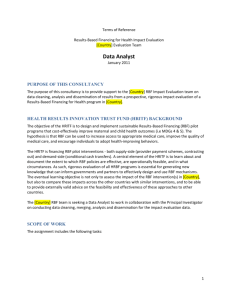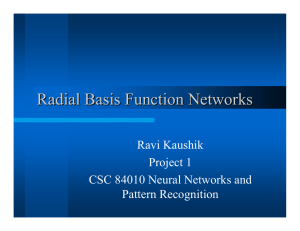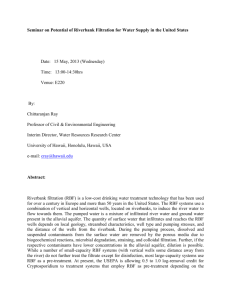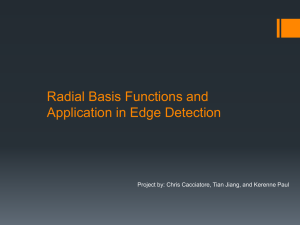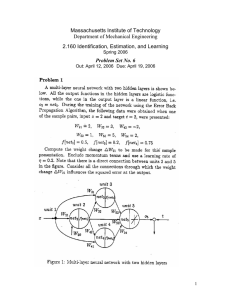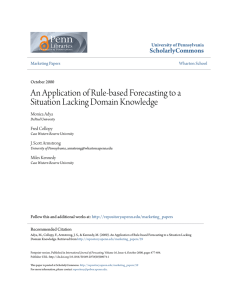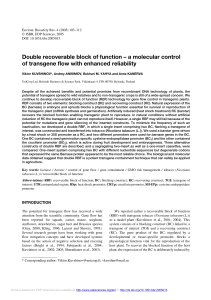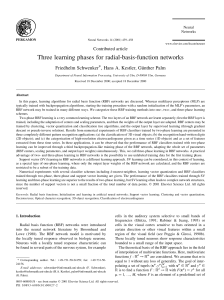Advance Journal of Food Science and Technology 6(8): 981-983, 2014
advertisement
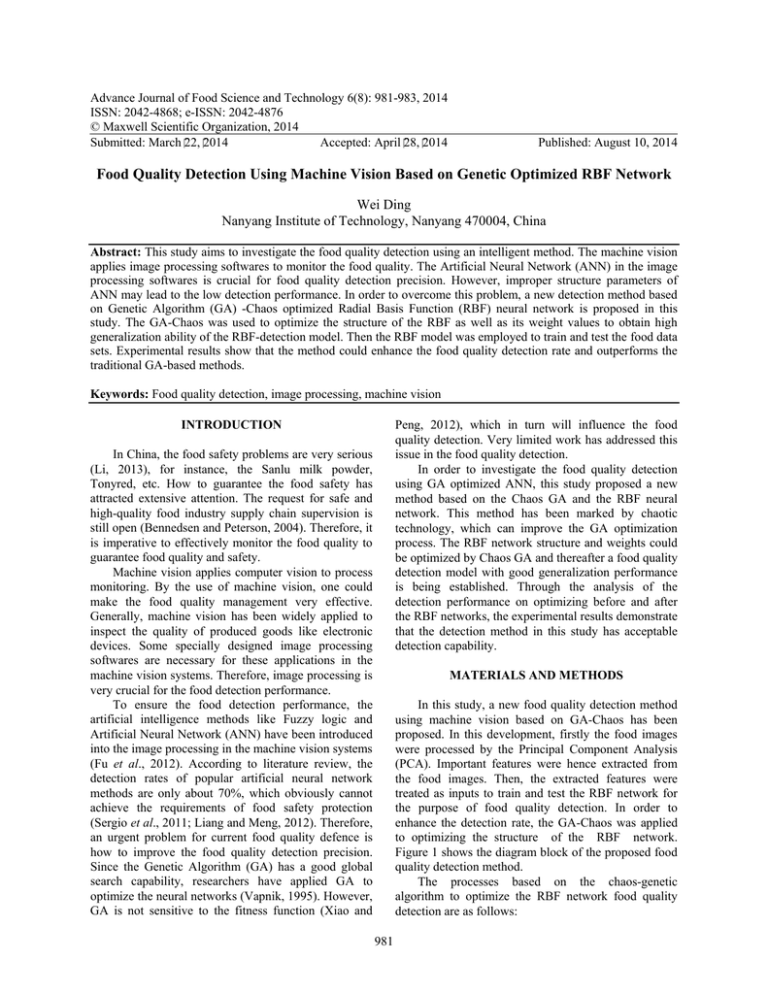
Advance Journal of Food Science and Technology 6(8): 981-983, 2014 ISSN: 2042-4868; e-ISSN: 2042-4876 © Maxwell Scientific Organization, 2014 Submitted: March 22, 2014 Accepted: April 28, 2014 Published: August 10, 2014 Food Quality Detection Using Machine Vision Based on Genetic Optimized RBF Network Wei Ding Nanyang Institute of Technology, Nanyang 470004, China Abstract: This study aims to investigate the food quality detection using an intelligent method. The machine vision applies image processing softwares to monitor the food quality. The Artificial Neural Network (ANN) in the image processing softwares is crucial for food quality detection precision. However, improper structure parameters of ANN may lead to the low detection performance. In order to overcome this problem, a new detection method based on Genetic Algorithm (GA) -Chaos optimized Radial Basis Function (RBF) neural network is proposed in this study. The GA-Chaos was used to optimize the structure of the RBF as well as its weight values to obtain high generalization ability of the RBF-detection model. Then the RBF model was employed to train and test the food data sets. Experimental results show that the method could enhance the food quality detection rate and outperforms the traditional GA-based methods. Keywords: Food quality detection, image processing, machine vision Peng, 2012), which in turn will influence the food quality detection. Very limited work has addressed this issue in the food quality detection. In order to investigate the food quality detection using GA optimized ANN, this study proposed a new method based on the Chaos GA and the RBF neural network. This method has been marked by chaotic technology, which can improve the GA optimization process. The RBF network structure and weights could be optimized by Chaos GA and thereafter a food quality detection model with good generalization performance is being established. Through the analysis of the detection performance on optimizing before and after the RBF networks, the experimental results demonstrate that the detection method in this study has acceptable detection capability. INTRODUCTION In China, the food safety problems are very serious (Li, 2013), for instance, the Sanlu milk powder, Tonyred, etc. How to guarantee the food safety has attracted extensive attention. The request for safe and high-quality food industry supply chain supervision is still open (Bennedsen and Peterson, 2004). Therefore, it is imperative to effectively monitor the food quality to guarantee food quality and safety. Machine vision applies computer vision to process monitoring. By the use of machine vision, one could make the food quality management very effective. Generally, machine vision has been widely applied to inspect the quality of produced goods like electronic devices. Some specially designed image processing softwares are necessary for these applications in the machine vision systems. Therefore, image processing is very crucial for the food detection performance. To ensure the food detection performance, the artificial intelligence methods like Fuzzy logic and Artificial Neural Network (ANN) have been introduced into the image processing in the machine vision systems (Fu et al., 2012). According to literature review, the detection rates of popular artificial neural network methods are only about 70%, which obviously cannot achieve the requirements of food safety protection (Sergio et al., 2011; Liang and Meng, 2012). Therefore, an urgent problem for current food quality defence is how to improve the food quality detection precision. Since the Genetic Algorithm (GA) has a good global search capability, researchers have applied GA to optimize the neural networks (Vapnik, 1995). However, GA is not sensitive to the fitness function (Xiao and MATERIALS AND METHODS In this study, a new food quality detection method using machine vision based on GA-Chaos has been proposed. In this development, firstly the food images were processed by the Principal Component Analysis (PCA). Important features were hence extracted from the food images. Then, the extracted features were treated as inputs to train and test the RBF network for the purpose of food quality detection. In order to enhance the detection rate, the GA-Chaos was applied to optimizing the structure of the RBF network. Figure 1 shows the diagram block of the proposed food quality detection method. The processes based on the chaos-genetic algorithm to optimize the RBF network food quality detection are as follows: 981 Adv. J. Food Sci. Technol., 6(8): 981-983, 2014 • If the results can satisfy the conditions for the termination, then stop to the end, otherwise return to (3) for iteration. RESULTS AND DISCUSSION In this study, the real food image data are analyzed to validate the detection performance of the proposed algorithm. In the image datasets there were 50 healthy apple images and 50 bad ones, 50 healthy potato images and 50 bad ones and 50 healthy tomato images and 50 bad ones. Therefore, there were 300 images in total. In the experiments, half of the images were used to train the RBF network and the other half were used for testing. Table 1 lists the testing results of the proposed method and its detection performance was compared to other algorithms in Table 2. As shown in Table 1, the proposed algorithm in this study can detect the food quality accurately. The detection rate was higher than 80%, the false rate was approaching 5.25%. Table 2 indicates that, after the optimization on the neural networks the food quality detection performance could be enhanced significantly. The detection rate and the false rate of the GA-Chaos were better than the traditional genetic optimization; meanwhile, the detection performance of the RBF network was better than that of the BP network. Fig. 1: The workflow diagram of the proposed food quality detection method • • • • • • Chromosomes will be coded by hidden nodes number, the base function of central values and the width of the RBF network. These three chromosomes form an individual. Individuals will be initialized and set the genetic operation parameters. The corresponding value of the fitness function will be calculated according to the solution space value. Crossover and mutation of genetic algorithm will proceed. Newborn progeny populations of each chromosome will be decoded and the corresponding fitness value will be obtained. The optimal individuals in groups will be selected for chaos optimization by the chaotic algorithm, if the new individual fitness value is bigger than the original individual, the individual will be substituted, otherwise the original individual stays unchanged. CONCLUSION The machine vision is applied to the food quality detection. In order to enhance the detection performance, this study develops a GA-Chaos optimized RBF network for the food quality detection. The innovation is that the development can eliminate genetic algorithm precocious phenomena by the use of Chaos searching. The experimental result has proven the effectiveness of the proposed method. Furthermore, the new method could afford technical support for the practical food quality protection. Table 1: The food quality detection results by chaos-GA and RBF Training --------------------------------------------------------------------------Detection rate (%) False rate (%) Food type Apple 88.75 5.25 Potato 87.25 5.25 Tomato 83.75 5.25 Testing --------------------------------------------------------Detection rate (%) False rate (%) 85.50 5.50 86.75 5.75 83.50 5.25 Table 2: Comparison of food quality detection results RBF --------------------------------------------------------------------------Detection rate (%) False rate (%) Optimization method Non 73.6 9.25 GA 80.4 7.25 Chaos-GA 86.6 5.25 BP --------------------------------------------------------Detection rate (%) False rate (%) 73.40 9.26 79.60 7.36 85.25 5.50 982 Adv. J. Food Sci. Technol., 6(8): 981-983, 2014 Liang, M. and D. Meng, 2012. Quality detection method research and simulation based on rice images. Comput. Simulat., 14(6): 23-27. Sergio, C., A. Nuria and M. Enrique, 2011. Advances in machine vision applications for automatic inspection and quality evaluation of fruits and vegetables. Food Bioprocess Tech., 4(4): 487-504. Vapnik, V., 1995. The Nature of Statistical Learning Theory. 1st Edn., Springer-Verlag, Berlin. Xiao, X. and L. Peng, 2012. Research of rice figure detection based on improved ant colony algorithm for image edge detection. Microcomp. Appl., 21(13): 85-90. REFERENCES Bennedsen, B. and D. Peterson, 2004. Identification of apple stem and calyx using unsupervised feature extraction. T. ASAE, 47(3): 889-894. Fu, S., S. Cai and X. Zhu, 2012. Design of intelligently online detection and analysis system for automobile transmission. Int. J. Digit. Content Technol. Appl., 6(11): 282-288. Li, H., 2013. Application research of food quality detection based on computer vision. J. Comput., 8(7): 1758-1762. 983

